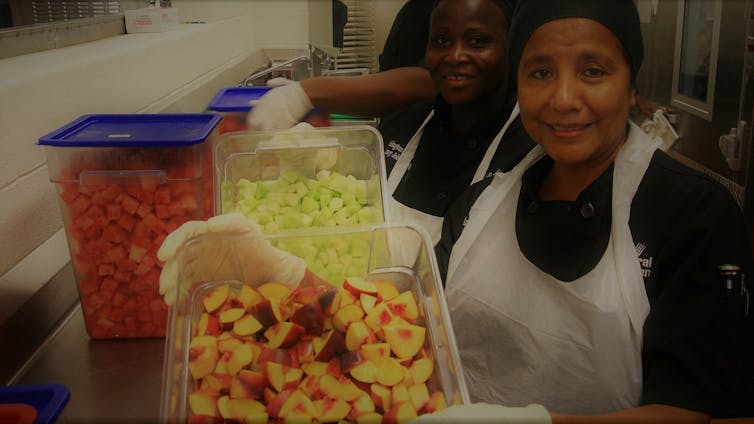Some new nonprofits take off, others flop – and nobody knows why
To learn why some new nonprofits prosper when others do not requires dealing with the fact that everyone has trouble remembering things the way they happened.

Wayne Gretzky’s observation that you will always miss 100 percent of the shots you don’t take holds true for charitable donors. They cannot expect great things to happen, or new innovations to take root, unless they are willing to take a shot at giving money to novel and promising new nonprofits.
Still, even the bravest and boldest donors don’t enjoy wasting money launching new nonprofits that either fail in the long run to thrive or fail to make significant progress toward achieving their missions. What donors are looking for is the next DC Central Kitchen – a nonprofit that wins acclaim for its social ventures. On top of serving free meals to people who need them, the organization trains jobless adults who turn wasted food into balanced meals for shelters and nonprofits and make healthy, scratch-cooked meals consumed in low-income schools.
Although entrepreneurially minded donors would benefit from expert guidance on how to spot the outfits most likely to succeed, there’s been virtually no research on this question. As a scholar focusing on how new nonprofits are founded and develop, I believe two shortcomings in how research regarding nonprofit startups gets done create this gap. And I believe that this problem stands in the way of figuring out why some new nonprofits thrive while others do not.

An obsession with success
Plenty of people like the notion of nonprofit entrepreneurship. This is not surprising, as much of what is said and written about this subject celebrates and spotlights success stories, and it’s human nature to revere achievement.
Success stories can certainly boost interest and excitement among nonprofit donors and other stakeholders. But what leads some nonprofit entrepreneurs to succeed and others to fail or just muddle along?
This is what academics call “selection bias” – paying attention to only one of many subsets rather than taking stock of them all. The Swedish entrepreneurship researcher Per Davidsson has eloquently illustrated why selection bias is a big deal with this paraphrased example:
Imagine that researchers want to investigate and isolate the factors that make gamblers successful. If they study only the gamblers who win all the time, they would reach the obviously false conclusion that gambling is always profitable.
Likewise, scholars who study only successful nonprofit ventures make the same mistake. In turn, their findings are biased and – I’m sad to say – flawed. Rather than remain inept, people like me must study successful and unsuccessful nonprofits alike.

Snapshot studies
A second shortcoming is the inclination to rely on research methods that investigate new nonprofits and the donors who fund them at a single point in time. One way that happens is that researchers rely on surveys that capture a nonprofit’s activities and accomplishments at a single juncture rather than over the course of months, years or decades.
But new nonprofits don’t just emerge out of nowhere. Creating and developing a thriving new nonprofit is a process, as I have explained in Nonprofit Management & Leadership, an academic journal.
Thus, distilling what makes new ventures prosper requires studying how they – and other nonprofits – evolve. Inevitably by their very nature, snapshot studies fail to explain how and why such changes take place.
Further, nonprofit studies seldom capture the earliest phases of new nonprofit activity, even though entrepreneurship and organizational researchers have argued what happens during these nascent stages shape organizations and have a long-lasting influence on them.
Consequently, those few scholars who actually try to look into startup dynamics rely on fleeting snapshots resort to asking founders or other key staff, board members and additional stakeholders about earlier events and actions long after they took place. But that approach is prone to another kind of error, memory distortion.
Measuring memory distortion
To investigate how accurately founders of new nonprofits recall past situations, assessments and motivations, I studied the same set of early stage nonprofit entrepreneurs at two different points in time.
The group I studied took part in a startup workshop in Kansas City in 2015 and early 2016 for people who want to create new nonprofits.
I asked participants in the workshop about three things: why they wanted to start a new nonprofit, where they anticipated getting funding and how likely they believed it would be that they might actually launch a new organization.
I followed up with an online survey six to 14 months later. The second survey asked respondents to recall what they what they said the first time around.
When comparing the two sets of answers, respondents frequently gave different ones the second time.
Three out of 10 recalled having a different reason for wanting to start a new nonprofit than they asserted in the first survey. And both of those reasons, of course, could not be accurate.
Nearly half incorrectly recalled the source of funding they had anticipated. The expected chances of a successful launch also differed. The people who did launch a new nonprofit were somewhat more likely to say they had anticipated this success during their second interview. The people who failed to get a new nonprofit up and running were nearly 20 percent less likely to say they expected to succeed during their later interview.
My findings suggest that after-the-fact inquiries regarding new nonprofits that succeed, no matter how honest and thoughtful founders or other key players are, may rely on wrong versions of of what happened during the startup phase. This finding serves as a warning to researchers who in retrospect try to figure out what happened during the launch process by asking entrepreneurs to share their founding stories.
Since stories are malleable, the best way to reduce the risk of hindsight bias is to observe startups from the very beginning and follow them over time.
Some people forget, others get the details mixed up and others ascribe a rationale they didn’t have in mind at the time when they’re asked about events that have already transpired.
The way forward
To be sure, it’s hard to assess the viability and probable longevity of newly created nonprofits. It would take significant time and money to undertake such a project.
Still, I believe that scholars who do research about nonprofits can better serve the people who want to create, fund or nurture new and innovative nonprofits by studying this type of entrepreneurship in a new way.
In particular, we scholars need to do more to study nonprofits over extended periods of time to better learn why they fail and thrive and how they change.
Fredrik O. Andersson does not work for, consult, own shares in or receive funding from any company or organisation that would benefit from this article, and has disclosed no relevant affiliations beyond their academic appointment.
Read These Next
Supreme Court case about ‘crisis pregnancy centers’ highlights debate over truthful advertising stan
There are some 2,500 of these centers across the United States. Many are located within a mile of an…
Trump’s second term is reshaping US science with unprecedented cuts and destabilizing policy changes
The Trump administration is rewriting the 80-year-old American social contract for science research.
My prescription costs what?! Pharmacists offer tips that could reduce your out-of-pocket drug costs
High prescription drug costs are leaving many patients frustrated and unable to afford their medications.






